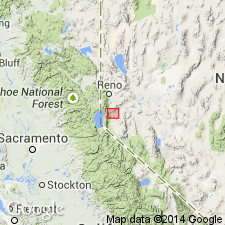
- Usage in publication:
-
- Lenihan Canyon Tuff*
- Modifications:
-
- Principal reference
- Dominant lithology:
-
- Latite
- Tuff
- AAPG geologic province:
-
- Great Basin province
Summary:
Named for Lenihan Canyon. Type section: exposures 0.8 km northeast of Lenihan Canyon NE/4 NE/4 sec.14 T16N R20E Virginia City quad, Storey Co, NV. Consists of pale-lavender-brown fine-grained hornblende-biotite quartz latite vitric-crystal tuff. Is 300 m thick. Principal reference locality: along west side of Hackett Canyon, secs.16 and 17 T15N R21E, and at Red House sec.32 T16N, R19E. Disconformably overlies Mickey Pass Tuff; unconformably underlies younger Tertiary rocks. Is older than Nine Hill Tuff (new). Biotite and sanidine from samples of Lenihan Canyon Tuff collected south of McClelland Peak yielded K-Ar ages of 26.7 +/-).8 and 25.1 +/-0.8 Ma (M.L. Silberman, written commun., 1976). Is Oligocene age.
Source: GNU records (USGS DDS-6; Menlo GNULEX).
For more information, please contact Nancy Stamm, Geologic Names Committee Secretary.
Asterisk (*) indicates published by U.S. Geological Survey authors.
"No current usage" (†) implies that a name has been abandoned or has fallen into disuse. Former usage and, if known, replacement name given in parentheses ( ).
Slash (/) indicates name conflicts with nomenclatural guidelines (CSN, 1933; ACSN, 1961, 1970; NACSN, 1983, 2005, 2021). May be explained within brackets ([ ]).

